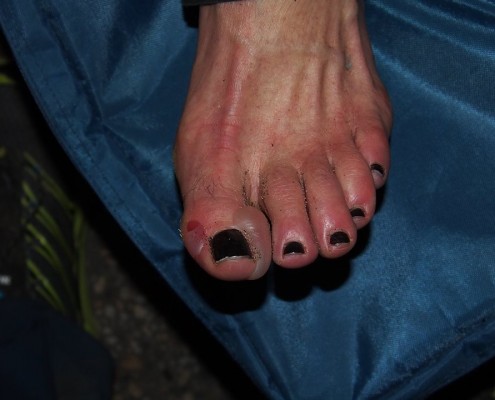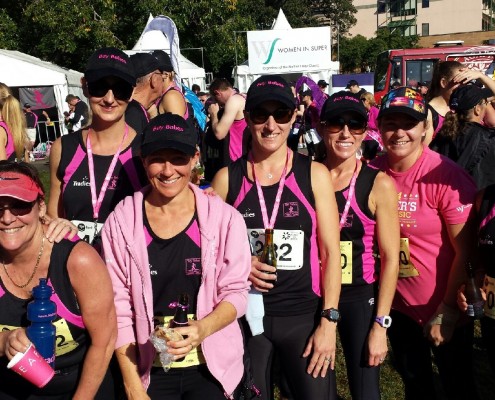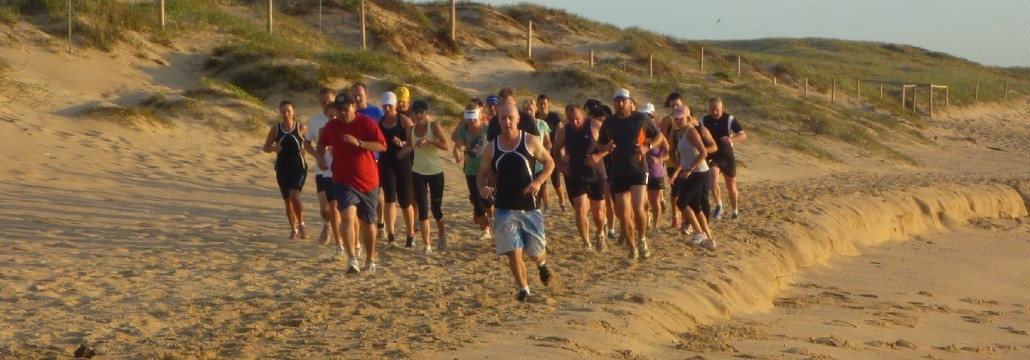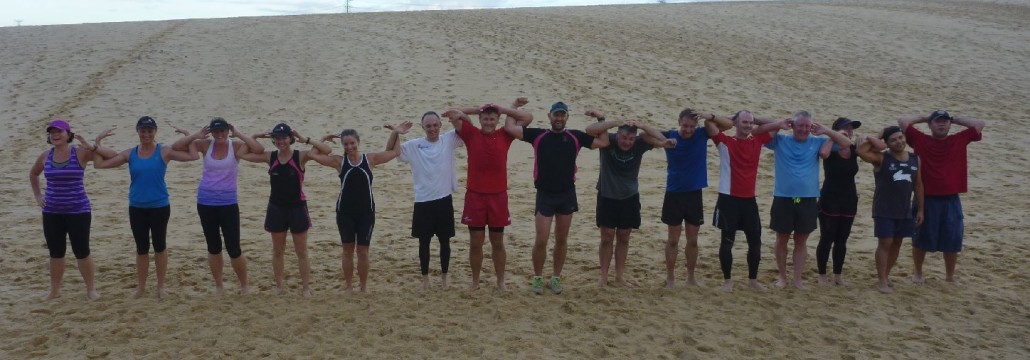So, you have decided to bite the bullet and do a Half Marathon! Good on you! I have set this plan around 20 weeks leading up to the Hunter Valley Running Festival Half in July 2014 so this plan should commence on the 15th March which is tomorrow! This only gives you 19 weeks and will be plenty, however you need to get cracking now! But before you do, I want you to start preparing yourself for the coming weeks that will get you over the line. So call this a pre-half marathon training program!
Before you start you need to:
- Get yourself properly fitted for a good pair of running shoes. You can expect to pay around $150-250 dollars for a decent pair of shoes but they are so important. All injuries generally start at the feet and if your shoes are wrong for you and you start punching out km’s in them you will end up injured and there goes your race! I recommend seeing Trent Wood at Southside Runners in Cronulla (9545 6010) to fit you, as he is one of the most experienced people in the industry. A pair of shoes should get you around 500km of training before you will need new ones. Just save them for running, not cross training when you are with me up at the oval. You will then need a new pair for race day.
- Comfortable clothes are important and need to be able to breathe and wick away sweat and avoid chafing. They don’t have to be fashionable, just practical.
- Invest in a drink belt that you can use to carry fluid and gels etc in. Nathan is a good brand and can be found online. GU products and similar energy supplements can be purchased locally at Endeavour Cycles Gymea, in Gymea Shopping Village, or even in your supermarket.
- Plan your days that you are going to train so that you can stick to the program and fit in cross training as well. To be a good runner you also need a good core and good strength so keep up your other classes as well. The rest days from running are good for this as they keep your aerobic fitness up too, while allowing the muscles used for running to have a breather.
- Start to pay attention to your diet and realise that you will need to fuel your body accordingly to have the energy to run long distances. This doesn’t mean you necessarily need to eat more, as you want to be leaner to run better, but eat differently and get enough carbs/proteins and good fats for fuel and recovery. You may need to look at mulitvitamins if your diet is inadequate to help with the additional strain on your body. More on this later. The better the nutritional quality of your food, the better your performance. Stay away from simple sugars and look for Low GI foods to provide you with the carbohydrates you need.
- Make sure you get good sleep while you are embarking on this journey as sleep is where you recover and get stronger.
- You need to start and do a few short runs each week for the next month to get yourself prepared for what is to come. If you are already comfortably running 5-6km this is great.
- I’d advise that you get yourself a Heart Rate Monitor – a very good training tool. Try the www.thepolarshop.com.au for great models and you can often get a good special.
- Get a friend or group of friends that you are going to do this week and make a pact to get through it together. You will have more fun in training and once race day comes along you will share in the glory together – just like these girls!

Gold Coast Glamour Girls 2011
TRAINING COMPONENTS
Your Half Marathon training plan should consist of the following elements to give you a good base and build speed, strength and endurance.
Tempo Runs
Medium-distance, sustained-pace run that is slightly uncomfortable. These workouts “improve your lactate threshold pace.” This sort of training gives you the ability to hold a high heart rate for longer. I call your lactate threshold your “spew point”!
Speed work
- Short Intervals – Warm up for 5 -10mins then run 400m, then cool down by walking 2 minutes; repeat x 3-5 to start with then increase as your fitness does. You can manipulate and play with intervals as long as your heart rate is high in the work period and you have a rest period. EG 200m fast, 30 sec rest/100m fast, 10 sec/1km hard, 2 minute recovery etc. Intervals “improve our anaerobic capacity” (working without oxygen), as well as promoting muscle development, and building speed.
- Hills – find a hill, roughly 5% gradient, (eg Ellesmere Rd from the driveway leading down to the baths to the park opp Mexican Restaurant) and mark out a 200-400m length on the hill; starting at the bottom, run up at a pace you can barely maintain from bottom to top, then cool down by walking or jogging slowly to the bottom; repeat. Hill training improves leg-muscle strength, quickens your stride, develops your cardiovascular system, enhances your running economy (makes you run more efficiently and saves you energy). As your fitness improves you could try running 800m at about 80% of maximum effort, then cool down by jogging for the same number of minutes as it took you, then repeat. This type of interval training has the same benefits as shorter intervals, as well as improving the ability to buffer lactic acid.
Relaxed Run
Medium-distance, relaxed-pace run. These are ‘recovery’ runs – they provide additional aerobic conditioning, and keep the muscles loose, without causing fatigue. This is the one you would skip if time poor or you are attending other regular sessions at the Oval.
LSD – Long Slow Distance
This is your weekly endurance run where you start to build endurance, improve your fat burning ability and where your muscles adapt to being on your legs for a long time. You are also training yourself to increase kilometres. You run a long distance, at a relaxed, easy pace. It is MOST IMPORTANT here to only increase your weekly distance by 5-10%, even if you feel good. This will help you to avoid injury and build the necessary muscle adaptations to build your endurance safely. You will work in roughly 4-5 week blocks where you will increase your distance by 5-10% for 3 weeks then on the 4th week you will knock it back to where you were in week two to have a rest week. At the start of week 1 in the second block you will again 5-10% per week form where you left off in the previous rest week and so on. Before you know it you can run for a long time!
EXAMPLE
LSD RUNS – 4 WEEK BLOCK
WEEK 1 – 7KM
WEEK 2 – 7.35- 7.7KM (5-10% INCREASE)
WEEK 3 – 7.7-8.5KM
WEEK 4- 7.35-7.7KM (BACK TO WEEK 2)
WEEK 1 – 7.7-8.5KM
WEEK 2 – 8-9.35KM
WEEK 3 – 8.4-10.3KM
WEEK 4 – 8-9.3KM (BACK TO WEEK 2)
NB If this is too confusing then below is a simpler way to work out increases
Format each week
DAY 1 – rest day
DAY 2 – Tempo training
DAY 3 – Rest day/Cross Training (strength/core/boxing etc)
DAY 4 – Speed work
DAY 5 – Relaxed run
DAY 6 – Rest day/Cross Training
DAY 7 – LSD – Distance run
You can work out which day of the week suits you to start ‘Day 1’.
Training Schedule
Note: the speeds provided correspond to a 2 hour half-marathon finish. If you plan to finish faster, or slower, adjust your speed accordingly. Remember to make the fourth week a rest week if you can, and drop your mileage to similar to that of the second week of the current block.
Week 1
This is a ‘getting started’ week. 3km easy run on Tuesday, 5km easy run on Friday, 7km easy run on Sunday, or days that suit.
Weeks 2-7
Tempo runs – 3km, increase by 0.5km each week @ 5:30/km pace
Speed work – short intervals 400m in 2minutes, 2 minute recovery jog; repeat 4 times on week 2, 6 times on week 3, and so on up to 14 times on week 7.
Relaxed runs – 5km @ 6:30 – 7:00 /km pace
Distance runs – 7km, increase by 1km each week @ 7:30/km pace
Weeks 8-13
Tempo runs – 5km, increase by 0.5km each week @ 5:30/km pace
Speed work – hill repeats 400m in 2minutes, jog slowly back down; repeat 2 times on week 8, 4 times on week 9, and so on up to 12 times on week 13.
Relaxed runs – 5km @ 6:30 – 7:00 /km pace
Distance runs – 10km, increase by 2km each week @ 7:30/km
Weeks 14-19
Tempo runs – 7km, 8km, 9km, 10km, 10km @ 5:30/km
Speed work – 800 m in 3:40, recovery jog 3:40; repeat 5 times on week 14, 6 times on week 15, and so on up to 10 times on week 19.
Relaxed runs – 5km @ 6:30 – 7:00 /km
Distance runs – 12km, increase by 2km each week @ 7:30/km pace
Week 20 (Race week)
Monday – rest day
Tuesday – 3km @7:00/km
Wednesday – rest day
Thursday – 5km @ 7:00/km
Friday – rest day
Saturday or Sunday – RACE DAY!!!
YOU DID IT!
FOODS TO EAT WHILST TRAINING
To train efficiently and give yourself enough fuel to cope with your runs, and also the proper nutrition to recover with, you need to be focused on your diet.
You need a combination of carbs and protein for fuel and recovery and good fats to provide essential fatty acids to help reduce inflammation in muscles and joints and to speed recovery.
Any run over 90 mins will require carb replacement such as energy gels and sports drinks. Anything under this and water during the run should be adequate, unless you feel yourself flagging then try a gel. Your body will become efficient at burning fat stores for fuel over time during your long runs.
Intervals and tempo runs however will use more carb stores quickly and need to be topped up beforehand, not during.
Here is a good guide that I found that will help you eat well and at the right times around your runs to maximise your efforts:
2 Hours Before:
- Low GI, slow digesting foods to top up carb stores and a little high quality protein.
- Best choice is fish and eggs and wholemeal (not wholegrain) bread. EG a poached egg on toast. Other choices are:
- Low fat plain yoghurt
- Chicken
- Brown rice
- Sweet potato
- Oats/porridge
- Wholegrain pasta
- Avoid fats
1 Hour Before
- Easily digested low GI carbs still a priority
- Best choice is a banana and low fat yoghurt
- Proteins from milk and cheese eg Up and Go, Sustagen Sport, cottage cheese, low fat yogurt.
- White rice is easily digested and hi GI for quick energy
- Egg whites (lower fat is required now so skip the egg yolk)
- Whey protein shake with skim milk
- Avoid fats
30 Minutes before
- Coffee – boosts endurance and lessons the perceived effort/pain
- Sports Drink – for carbs, fluids, salt and electrolytes
- Water – for hydration
- Green Tea – promotes fat usage
NB If your run is less than an hour stick to water but over that sip on sports drinks.
20 Minutes In
- Water – approx 500ml per hour
1 hour In
- Sports drink
- Whey protein shake.
Research shows that mixing protein with carbs increases the rate of replenishment, reduces muscle damage and can boost time to exhaustion by 15%. Try a sports drink with electrolytes and 30g of carbs and 10-15g unflavoured whey protein mixed before you go and in placed in a drink belt bottle.
Straight After
- Hi GI fast absorbing carbs are what you need here to recover along with protein. A 4:1 ratio of carbs to protein is recommended. EG 20-30g chicken breast with 80g cooked white rice.
- Fruit is effective too which restores liver glycogen more effectively than other carbs.
- A great option is chicken, rice and fruit salad.
- If you are short on time an Up & Go Energise is great to have on hand in an esky in the car, or you can pick one up form a service station.
- Don’t forget electrolytes if it’s hot or you are a heavy sweater, or if you have been out for a very long time. A Gatorade or similar is fine.
2 Hours After
- Omega-3 rich foods reduce inflammation in muscles and joints and speed recovery, promote insulin sensitivity and are the key to good carb stores for your next run.
- Antioxidants to help repair and help the immune system which cops a beating during training – include heaps of leafy green vegetables, broccoli, blueberries, green tea and colour foods like red capsicum.
- Chia seed, flax seeds, raw almonds.
- Fish, especially oily fish like salmon.
- Good meal idea – thai salmon, vegies like bok choy and broccoli and capsicum with coconut milk and noodles.
GOOD LUCK!







